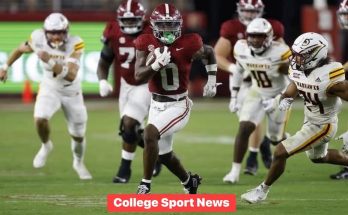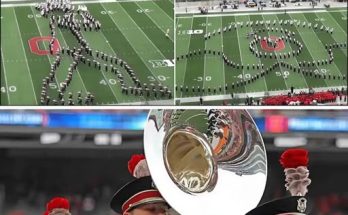Cam Coleman, the highly coveted wide receiver from the Southeastern Conference (SEC), has made headlines by signing with the Oklahoma Sooners, setting a new record for the highest trade value in college football history. This unprecedented move has sent shockwaves through the college football landscape, highlighting the evolving dynamics of recruitment and the increasing influence of Name, Image, and Likeness (NIL) deals.
Background and Recruitment
Cam Coleman, a 6-foot-3, 197-pound wide receiver from Phenix City, Alabama, emerged as one of the most sought-after talents in the 2024 recruiting class. Initially committed to Texas A&M, Coleman flipped his commitment to Auburn in December 2023, signaling his intent to play in the SEC. During his freshman season at Auburn, he showcased exceptional skills, recording 37 receptions for 598 yards and 8 touchdowns, averaging 16.2 yards per catch.
Despite his impressive performance, Coleman chose to enter the transfer portal in December 2024, expressing his desire to explore new opportunities. His decision to leave Auburn sent ripples through the college football community, as he was considered one of the most dynamic players in the conference.
The Transfer to Oklahoma
After a period of speculation and interest from multiple programs, Coleman announced his commitment to the Oklahoma Sooners on February 1, 2025. This decision was particularly surprising, as Oklahoma is not traditionally known for recruiting in the SEC footprint. Coleman’s choice to join the Sooners underscores the increasing mobility of players and the broader national reach of college football recruitment.
Record-Breaking NIL Deal
Coleman’s transfer to Oklahoma was accompanied by a groundbreaking NIL deal, reportedly setting a new record for the highest trade value in college football history. While specific figures have not been publicly disclosed, sources indicate that the deal surpasses previous records, reflecting the escalating financial stakes in college athletics.
This development highlights the significant impact of NIL agreements on recruitment and player movement. As NIL deals become more lucrative, they are increasingly influencing players’ decisions, leading to a more dynamic and competitive recruiting environment.
Implications for College Football
Coleman’s transfer and the associated record-breaking NIL deal have several implications for college football:
- Enhanced Recruiting Competition: Programs are now competing not only on the field but also in securing lucrative NIL deals for prospective players. This shift is prompting schools to invest more in their NIL programs to attract top talent.
- Player Empowerment: Athletes like Coleman are leveraging NIL opportunities to maximize their earning potential, leading to a more player-centric landscape in college sports.
- Market Dynamics: The escalating value of NIL deals is influencing the broader market, with companies and boosters playing a more prominent role in recruitment and player retention.
Impact on Oklahoma’s Football Program
Oklahoma Sooners fans are understandably excited about the arrival of a player with Cam Coleman’s talent and potential. The Sooners have long been a powerhouse in college football, but with the SEC becoming an increasingly competitive conference, the addition of a top-tier wide receiver like Coleman could give the program a major edge in future seasons. His versatility and explosiveness as a receiver make him a dynamic weapon, capable of stretching defenses and opening up opportunities for other offensive players.
Oklahoma’s offense, traditionally strong under head coach Brent Venables, now has the potential to be even more dangerous with a star player like Coleman on the roster. Coleman’s ability to make plays in critical situations and his deep threat could make Oklahoma a serious contender for both conference and national championships in the years to come.
Furthermore, Coleman’s arrival signals that the Sooners are serious about competing with the best programs in the country, not only in terms of on-field performance but also in terms of recruitment and NIL opportunities. The Sooners’ ability to secure such a highly coveted player suggests they are adapting to the evolving landscape of college football, where securing top players is just as much about financial backing and NIL negotiations as it is about traditional recruiting methods.
The Changing Landscape of College Football Recruiting
Coleman’s decision to sign with Oklahoma also highlights the ongoing shift in college football recruiting. As the NCAA continues to navigate the complexities of NIL, transfer portals, and changing conference alignments, players are gaining more control over their future than ever before. This represents a stark contrast to the traditional college recruiting model, where schools had much more power in determining where a player would go.
With the ability to negotiate NIL deals, athletes now have the freedom to make decisions based not only on athletics and academics but also on financial opportunities. The influx of money into college sports, driven by both NIL and broadcast rights, is rapidly changing the college football ecosystem. Programs like Oklahoma that are willing to adapt and push the envelope in terms of offering lucrative NIL packages are finding themselves on the cutting edge of recruiting. This gives them a distinct advantage over programs that may still be reluctant or slow to embrace these changes.
However, there is also a level of caution and concern among some critics. As NIL deals become more prominent, there is the risk that it could further skew the competitive balance in college football. Programs with bigger financial resources could dominate recruitment, potentially leaving smaller schools at a disadvantage.
Moreover, NIL-driven recruitment could lead to increased player movement, as athletes may transfer to programs offering more lucrative opportunities or better chances of exposure and media attention. This fluidity could disrupt traditional team-building strategies and create an even more unpredictable environment in college sports.
What This Means for the Future of SEC Programs
While Cam Coleman’s decision to join Oklahoma is significant, it also has ramifications for SEC programs. The SEC has long been the most competitive conference in college football, with powerhouse schools like Alabama, Georgia, LSU, and others constantly battling for supremacy. The emergence of NIL deals, however, is beginning to level the playing field in some respects, allowing schools outside the traditional SEC elite to land top-tier recruits.
For SEC teams, this is both an opportunity and a challenge. On one hand, SEC schools like Alabama and Georgia can use their winning traditions and established programs to offer top recruits the chance to compete for national championships. On the other hand, schools like Oklahoma are showing that with the right NIL resources, they can poach high-profile players from within the SEC and other conferences, weakening their rivals.
For schools within the SEC, this means an increased emphasis on boosting their NIL programs to attract and retain top talent. They will need to be innovative in how they present opportunities to recruits, offering not just financial incentives but also the chance to compete at the highest level. It’s no longer enough to just have a storied program; programs must now compete financially to stay relevant in an increasingly transactional recruiting landscape.
The Role of NIL Deals in Player Development
As NIL deals continue to grow in value, it’s also important to consider the potential impact on player development. While the financial rewards can be substantial, they can also present challenges for young athletes. Balancing the pressures of NIL deals, academic commitments, and athletic development can be difficult, particularly for athletes who are just beginning their college careers.
Coleman’s experience will be closely watched as he transitions to Oklahoma. As one of the most high-profile signees in recent memory, his ability to handle the expectations and pressures that come with his NIL deal could set a precedent for future athletes. Will he be able to maintain focus on his development as a player while managing the financial side of his career? Or will the distractions of NIL deals negatively affect his on-field performance?
This is a question that will continue to surface as more athletes take advantage of NIL opportunities. Programs like Oklahoma will need to have support systems in place to help players navigate the complexities of being a college athlete in this new era.
A New Era of College Football: What’s Next?
Cam Coleman’s signing with the Oklahoma Sooners is more than just a major recruiting win for the program; it represents a shift in how college football is played and marketed. The emphasis on NIL deals is reshaping how players think about their college careers, moving them away from traditional recruitment toward a more business-minded approach to their future.
As more players enter the transfer portal and take advantage of NIL opportunities, it’s clear that college football is entering a new era. In this new landscape, schools that can offer both athletic development and financial rewards will rise to the top, while programs that fail to adapt may fall behind. The growing influence of NIL will only continue to affect the sport, with more players likely to follow in Coleman’s footsteps, making moves based not just on football fit, but on financial opportunities as well.
In the years to come, we may see more high-profile players transferring between schools, not just because of athletic or academic reasons, but because of the financial incentives available. This could dramatically change how fans and analysts view college football, with programs having to manage not only the performance of their teams but also the financial interests of their players.
The Cam Coleman signing is just the beginning of this new era. The question now becomes: how will this shift impact the broader college football landscape, and who will rise to the occasion next? Only time will tell.



